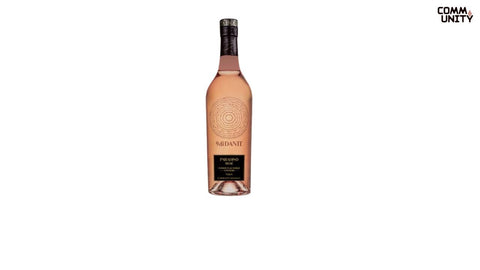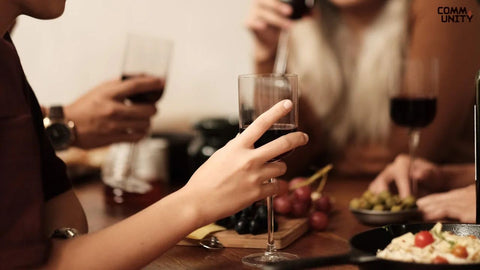Understanding how many glasses of wine are in a bottle is essential for planning events and managing servings.
As seasoned professionals in both wine and hospitality, we’ve crafted this complete guide to give you precise answers, useful breakdowns, and a professional-level grasp of wine serving standards that follow wine etiquette.
Whether you're organizing a dinner party, curating a wine tasting, or simply want to know “how many glasses of wine in a bottle,” or in a glass, this guide covers it all in precise detail.

9 di Dante Paradiso Rose Vermouth di Torino Superiore 750ml
Standard Wine Bottle Size and Pour
A standard wine bottle contains 750 milliliters (ml) of wine. When poured equally, this equates to 5 standard glasses of wine, with each glass being approximately 5 ounces (150 ml). Therefore, the wine bottle glass count for a standard wine bottle is approximately 5.
This 5-ounce serving is the industry norm that’s typically followed in established restaurants and formal gatherings. It's considered a balanced portion that offers optimal aroma and taste without overwhelming the drinker.
Glass Sizes and Pour Variations
While the standard pour is 5 ounces, actual wine bottle sizes and servings can vary depending on the context and type of wine.
Typical Serving Sizes by Context
-
Casual home pour: 5 to 6 ounces
-
Restaurant pour: Generally 5 ounces
-
Wine tasting: 2 ounces
-
Generous pour: 6 to 8 ounces (quite often in informal settings)
-
Large wine glasses: Can easily hold 12 to 22 ounces, but should only be filled to one-third for proper aeration
Regardless of the glass size, the 750 ml bottle consistently yields about five 5-ounce pours.
How Many Glasses in Different Bottle Sizes
Wine is not only sold in standard 750 ml bottles and is sold in bottles that hold different quantities. Below is a breakdown of how many glasses are in various bottle sizes:
|
Bottle Size |
Volume (ml) |
Glasses (5 oz) |
|
Quarter Bottle (Piccolo/Split) Half Bottle (Demi) |
187 mL 375 mL |
1 glass 2.5 glasses |
|
Standard Bottle |
750 mL |
5 glasses |
|
Magnum |
1.5 L |
10 glasses |
|
Jeroboam |
3 L |
20 glasses |
|
Rehoboam |
4.5 L |
30 glasses |
|
Methuselah |
6 L |
40 glasses |
|
Salmanazar |
9 L |
60 glasses |
|
Balthazar |
12 L |
80 glasses |
|
Nebuchadnezzar |
15 L |
100 glasses |
Larger bottles (Magnum, i.e., 1.5 L and above) are typically used for celebrations, aging, or showcasing a specific vintage. The larger the bottle, the more efficient it is for group servings, as the wine bottle glass count is also higher for these.
Red vs. White Wine Pours
Regardless of wine bottle sizes and servings, the pour size remains consistent across red and white wines. However, glass shape and occasion may influence how wine is served:
-
Red wine glasses are often larger with a wider bowl. This allows better oxygen exposure, which enhances flavor.
-
White wine glasses are usually narrower, as white wines benefit from less aeration.
Even so, each glass should still be poured to about one-third full, regardless of shape or wine type. This maintains the standard 5-ounce serving.
Sparkling Wines and Champagne Bottles
When serving sparkling wines like Champagne, the typical wine pour measurement is slightly less, about 4 ounces per glass to preserve the carbonation and minimize spillage due to bubbles.
A 750 ml bottle of sparkling wine yields 6 glasses of 4 ounces each and is ideal for toasts or celebratory events.
In formal events, especially weddings, the pour may be even smaller, closer to 3 ounces, allowing a single bottle to serve up to 8 guests.
How to Accurately Measure a Wine Pour
Ensuring each pour is consistent is crucial, especially in commercial settings. Here are tools and tips to maintain accuracy:
-
Jiggers or measuring pourers: Used by professionals to control exact ounces
-
Wine markers on glasses: Some glasses have fill lines etched subtly
-
Wine pourer spouts: Attach to the bottle to regulate flow
This accuracy helps with inventory control, cost management, and responsible serving.
(Note: Never underestimate the power of practice. In fact, make it a routine until you master wine pouring. For practice, pour water into a carafe with a 5 ounce line.)
Alcohol Content: What One Glass Really Means
A 5-ounce pour of wine at 12% alcohol by volume (ABV) contains roughly 0.6 ounces of pure alcohol. This is considered one standard drink in the U.S.
Different wines have varying ABVs:
-
Light whites: 9–11% ABV
-
Full-bodied reds: 13–15% ABV
-
Fortified wines (like Port): 17–20% ABV
As is clear from the above details, even if the volume stays the same, alcohol strength differs by type, impacting how many glasses should reasonably be consumed in one sitting.
Event Planning: Planning How Much Wine is Needed
To calculate the exact wine bottle glass count you need for your event, use the following guideline:
For a 2-hour dinner party:
-
Plan for 2 glasses per person
-
One bottle serves 2.5 people
Example: 10 guests × 2 glasses = 20 glasses = 4 bottles
For weddings or longer receptions (4+ hours):
-
Estimate 3 to 4 glasses per guest
-
One bottle serves 1.25 to 1.6 guests
Example: 100 guests × 3 glasses = 300 glasses = 60 bottles
Always round up, especially if you're not mixing in other alcohol types.
Wine Flights and Tastings
Wine tastings involve smaller pours of different wines to allow guests to sample multiple types without consuming too much alcohol.
-
A tasting pour is typically 2 ounces
-
A standard bottle gives about 12 tasting servings
When planning a tasting with 5 wines for 12 people, 5 bottles total will be sufficient.
Storage and Leftovers
Once opened, wine begins to oxidize. Here’s how long different types last:
-
Red wine: 3–5 days (recorked and stored in a cool place)
-
White wine: 3–5 days (refrigerated)
-
Sparkling wine: 1–3 days (with a sparkling wine stopper)
-
Fortified wine: Up to 28 days when stored in a cool, dark place
To extend shelf life, also consider vacuum sealers or argon gas wine preservers.
While a standard 750 ml wine bottle yields five 5-ounce glasses, the context, glassware, and wine type influence real-world serving sizes.
Knowing the right pour ensures enjoyable, responsible consumption and effective planning—whether for a quiet dinner or a large-scale event. With this guide, you’re equipped to serve and enjoy wine with accuracy and elegance.
FAQs
Can you get six glasses from one bottle of wine?
Yes, but each glass will be around 4.2 ounces, slightly under the standard pour. It’s common in tasting settings or when trying to stretch servings.
How many bottles for a party of 25 people?
Assuming 2 glasses per guest:
-
25 × 2 = 50 glasses
-
50 / 5 = 10 bottles
Round up to 11 or 12 if guests are wine enthusiasts or if the event is longer.
Is it acceptable to pour more than 5 ounces?
In informal settings, larger pours are common, but in formal service or restaurants, 5 ounces is standard for quality control, experience, and responsible drinking.
Buy the best wines from Community Wine and Spirits, whether you’re a wine enthusiast or want to keep some for special occasions.

